ADDITIONAL QUESTIONS FOR PRACTICE VERY SHORT ANSWER QUESTIONS
- What happens when a ray of light falls normally on the surface of a mirror?
- How image can be located which is formed by a plane mirror?
- What is lateral inversion? Explain with a suitable example.
- Why are reflecting prisms used in periscopes?
- Draw the following diagram and show the formation of image of the object AB with the help of suitable rays.
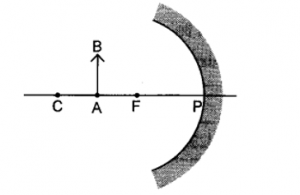
- Redraw the diagram given below in your answer book and show the direction of the light ray after reflection from the mirror.

- Redraw the diagram given below in your answer book and show the direction of the light ray after reflection from the mirror.
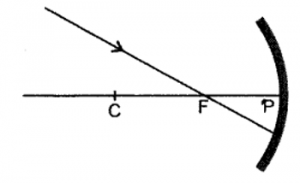
- Redraw the diagram given below in your answer book and show the direction of the light ray after reflection from the mirror.
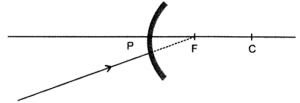
- An object is placed between the pole and focus of a concave mirror. What is the nature and size of image?
- Explain why a ray of light passing through the centre of curvature of a concave mirror, gets reflected along the same path.
- Between which two points of a concave mirror should an object be placed to obtain a magnification of -3?
- Between which two points related to a concave mirror should an object be placed to obtain on a screen an image twice the size of the object?
- The outer surface of a hollow sphere of aluminium of radius 50 cm is to be used as a mirror. What will be the focal length of this mirror? Which type of spherical mirror will it provide?
- What is the nature of the image formed by a concave mirror if the magnification produced by the mirror is +3?
- Which kind of mirrors are used in the headlights of a motor-car and why?
- Give the applications of plane mirror.
- What is meant by refraction?
- How should a ray of light be incident on a rectangular glass slab so that it comes out from the opposite side of the slab without being displaced? [Foreign]
- Mention two properties of a wave: one property which varies and the other which remains constant when the wave passes from one medium to another.
- Name one factor on which the direction of bending of a ray of light depends.
- State Snell’s law.
- Do frequency and wavelength change when light travels from one medium to another?
- Express the refractive index of the medium.
- If a ray of light passes from medium I to medium II without any change of direction, what can be said about the refractive indices of these media.
- What is the relation between speed of light in a medium and refractive index?
- Define refractive index in terms of velocity and mass density.
- A glass slab is placed over a page in which letters are printed in different colours. Will the image of all the letters lie in the same plane?
- Does the apparent depth of a tank of water change, normally?
- What happens to light when it enters a rarer medium from a denser medium?
- Light of wavelength 500nm in air enters a glass plate of refractive index 1.5. Find its wavelength in glass.
- The refractive index of carbon disulphide is 1.63. What is the meaning of this statement in relation to speed of light?
- The refractive index of diamond is 2.42. What is the meaning of this statement in relation to speed of light?
- A ray of light enters a rectangular glass slab of refractive index 1.5. It is found that the ray emerges from the opposite face of the slab without being displaced. If its speed in air is 3 × 108 ms-1 then what is its speed in glass?
- The speed of light in a transparent medium is 0.6 times that of its speed in vacuum. What is the refractive index of the medium?
- The refractive indices of four media A, B, C and D are given in the following table:
| Medium | A | B | C | D |
| Refractive Index | 1.33 | 1.50 | 1.52 | 2.40 |
If light, travels from one medium to another, in which case the change in speed will be (i) minimum, (ii) maximum?
- If a light ray IM is incident on the surface AB as shown, identify the correct emergent ray.
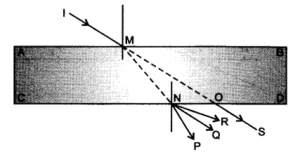
- What is a convex lens?
- Write the names of the different types of convex lenses.
- What is radius of curvature of a lens?
- What is optical centre?
- What is centre of curvature of a lens?
- Define focus of a convex lens. Draw a ray diagram showing the focus.
- How a virtual image bigger than the object can be produced?
- Redraw the given diagram and show the path of the refracted ray

- Redraw the given diagram and show the path of the refracted ray

- Redraw the diagram given below in your answer book and show the direction of the light ray after refraction from the lens.
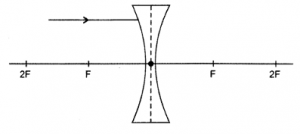
- Why does a ray of light bend when it travels from one medium into another?
- Redraw the diagram given below in your answer book and show the direction of the light ray after refraction from the lens.
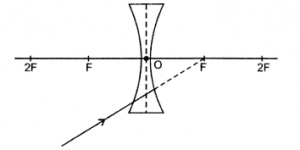
- How are focal length and radius of curvature connected?
- A concave mirror produces 3 times magnified real image of an object placed at 10 cm in front of it. Where is the image located?
- Give one application for convex mirror and convex lens.
- A girl was playing with a thin beam of light from her laser torch by directing it from different directions on a convex lens held vertically. She was surprised to see that in a particular direction the beam of light continues to move along the same direction after passing through the lens. State the reason for this observation.
- What does the positive sign associated with the virtual image and the negative sign associated with the real image denote?
- Define power of a lens. Name the lens for which power is positive.
- Define 1 dioptre.
- A stamp collector uses a lens (convex) of focal length 7 cm, to examine a stamp. What is the power of the lens?
- SHORT ANSWER QUESTIONS- I
- State the basic laws which determine the reflection of light by mirrors.
- State the two laws of reflection of light.
- List four properties of the image formed by a plane mirror.
- Distinguish between a real and a virtual image of an object. What type of image is formed (i) by a plane mirror, (ii) on a cinema screen?
- Define principal focus of concave and convex mirror.
- Define the focus of a concave mirror. If the radius of curvature of a convex mirror is 30 cm, what would be its focal length?
- What is the minimum number of rays required for locating the image formed by a concave mirror for an object? Draw a ray diagram to show the formation of a virtual image by a concave mirror.
- Define and show on a diagram, the following terms relating to a concave mirror:
(i) Aperture
(ii) Radius of curvature - List four properties of the image formed by a concave mirror, when object is placed between focus and pole of the mirror.
- List four properties of the image formed by a convex mirror.
- What is the nature, size and position of the image formed of an object at infinity? Explain how it is used as a doctor’s mirror.
- How will you distinguish between a plane mirror, a concave mirror and a convex mirror without touching them?
- A concave lens of focal length 15 cm, forms an image 10 cm from the lens. How far is the object placed from the lens? Draw the ray diagram.
- An object is placed at a distance of 10 cm from a convex mirror of focal length 15 cm. Find the position and nature of the image.
- Explain with the help of a diagram, why a pencil partly immersed in water appears to be bent at the water surface.
- State Snell’s law. Give its uses.
- Can the laws for plane refracting surfaces be applied to spherical refracting surfaces also? State the laws of refraction of light.
- Why do stars twinkle on a clear night?
- The refractive index of dense flint glass is 1.65, and for alcohol it is 1.36, with respect to air. What is the refractive index of dense flint glass with respect to alcohol?
- Light, of wavelength of 500 nm in air, enters a glass plate of refractive index 1.5.
Find
(i) speed
(ii) frequency and
(iii) wavelength of light in glass.
Assume that the frequency of light remains the same in both media.? - The refractive index of water is 1.33 and the speed of light in air is 3 × 108 ms-1. Calculate the speed of light in water.
- The refractive index of glass is 1.50 and the speed of light in air is 3 × 108 ms-1. Calculate the speed of light in glass.
- Explain the path of the light traveling in air incident on a rectangular glass block and emerging out into the air from the opposite face. Draw a ray diagram to show the complete path of this ray of light.
- In an experiment with a rectangular glass slab, a student observed that a ray of light incident at an angle of 55° with the normal on one face of the slab, after refraction strikes the opposite face of the slab before emerging out into air making an angle of 40° with the normal. Draw a labelled diagram to show the path of this ray. What value would you assign to the angle of refraction and angle of emergence?
- A ray of light, incident obliquely on a face of a rectangular glass slab placed in air emerges from the opposite face parallel to the incident ray. State two factors on which the lateral displacement of the emergent ray depends.
- To instruct a ray diagram, we use two light rays which are so chosen that it is easy to know their directions after refraction from the lens. List these two rays and state the path of these rays after refraction. Use these two rays to locate the image of an object placed between ‘F and ‘2F of a convex lens.
- Draw ray diagrams to represent the nature, position and relative size of the image formed by a convex lens for the object placed:
(a) at 2F1
(b) between F1 and the optical centre O of lens: - Draw ray diagrams to show image formation.
Object at C – concave mirror
Object beyond 2f – convex lens
Object at infinity – concave lens. Write the nature of the image in each case.
III. SHORT ANSWER QUESTIONS – II
- Draw the ray diagram and also state the position, relative size and nature of the image formed by a concave mirror when the object is placed between its centre of curvature, C and focus, F.
Answer.
Position of object: Beteween F and C
Position of image: Beyond C
Nature of Image: Real, inverted and enlarged.
- An object is placed between infinity and the pole of a convex mirror. Draw a ray diagram and also state the position, the relative size and the nature of the image formed.
- With the help of a ray diagram explain why a convex mirror is preferred for rear view mirrors in motor cars.
- An object 2 cm in size is placed 30 cm in front of a concave mirror of focal length 15 cm. At what distance from the mirror should a screen be placed in order to obtain a sharp image? What will be the nature and the size of the image formed? Draw a ray diagram to show the formation of the image in this case.
- State the type of mirror preferred as (i) rear view mirror in vehicles, (i0 shaving mirror. Justify your answer giving two reasons in each case. ?
- Name the type of mirror used in the following situations:
(i) Headlights of a car (ii) Rear-view mirror of vehicles (iii) Solar furnace
Support your answer with reason.
- An object 5 cm high is held 25 cm away from a converging lens of focal length 10 cm. Draw the ray diagrams and find the position, size and the nature of the image formed.
- Define refractive index of a transparent medium. What is its unit? Which has a higher refractive index, glass or water?
- A ray of light travelling in air enters obliquely into water. Does the light ray bend towards or away from the normal? Why? Draw a ray diagram to show the refraction of light in this situation.
- (a) “The refractive index of diamond is 2.42”. What is the meaning of this statement?
(b) Name a liquid whose mass density is less than that of water but it is optically denser than water. - What is understood by lateral displacement of light? Illustrate it with the help of a diagram. List any two factors on which the lateral displacement of a particular substance depends.
- What is the principle of reversibility of light? Show that the incident ray of light is parallel to the emergent ray of light when light falls obliquely on a side of a rectangular glass slab.
- An object 2 cm high is placed at a distance of 64 cm from a white screen. On placing a convex lens at a distance of 32 cm from the object it is found that a distinct image of the object is formed on the screen. What is the focal length of the convex lens and size of the image formed on the screen? Draw a ray diagram to show the formation of the image in this position of the object with respect to the lens.
- A concave lens has focal length of 20 cm. At what distance from the lens a 5 cm tall object is placed so that it forms an image at 15 cm from the lens? Also calculate the size of the image formed.
- An object 50 cm tall is placed on the principal axis of a convex lens. Its 20 cm tall image is formed on the screen placed at a distance of 10 cm from the lens. Calculate the focal length of the lens.
- The image of a candle flame placed at a distance of 45 cm from a spherical lens is formed on a screen placed at a distance of 90 cm from the lens.Identify the type of lens and calculate its focal length. If the height of the flame is 2 cm, find the height of its image.
- A 6 cm tall object is placed perpendicular to the principal axis of a convex lens of focal length 15 cm. The distance of the object from the lens is 10 cm. Find the position, size and nature of the image formed, using the lens formula.
- A 4 cm tall object is placed perpendicular to the principal axis of a convex lens of focal length 24 cm. The distance of the object from the lens is 16 cm. Find the position, size and nature of the image formed, using the lens formula.
- A convex lens has a focal length of 10 cm. At what distance from the lens should the object be placed so that it forms a real and inverted image 20 cm away from the lens? What would be the size of the image formed if the object is 2 cm high? With the help of a ray diagram show the formation of the image by the lens in this case.
- For which position of the object does a convex lens form a virtual and erect image? Explain with the help of a ray diagram.
- At what distance should an object be placed from a convex lens of focal length 18 cm to obtain an image at 24 cm from it on the other side. What will be the magnification produced in this case?
- How far should an object be placed from a .convex lens of focal length 20 cm to obtain its image at a distance of 30 cm from the lens? What will be the height of the image if the object is 6 cm tall?
- The image of an object placed at 60 cm in front of a lens is obtained on a screen at a distance of 120 cm from it. Find the focal length of the lens. What would be the height of the image if the object is 5 cm high?
- LONG ANSWER QUESTIONS
- Draw the ray diagram in each case to show the position and nature of the image formed when the object is placed:
(i) at the centre of curvature of a concave mirror
(ii) between the pole P and focus F of a concave mirror
(iii) in front of a convex mirror
(iv) at 2F of a convex lens
(v) in front of a concave lens - (a) It is desired to obtain an erect image of an object, using a concave mirror of focal length
20 cm.
(i) What should be the range of distance of the object from the mirror?
(ii) Will the image be bigger or smaller than the object?
(iii) Draw a ray diagram to show the image formation in this case.
(b) One half a convex lens of focal length 20 cm is covered with a black paper.
(i) Will the lens produce a complete image of the object?
(ii) Show the formation of image of an object placed at 2F1 of such covered lens with the help of a ray diagram.
(iii) How will the intensity of the image formed by half-covered lens compare with non-covered lens? - List the sign conventions for reflection of light by spherical mirrors. Draw a diagram and apply these conventions in the determination of focal length of a spherical mirror which forms a three times magnified real image of an object placed 16 cm in front of it.
- (a) If the image formed by a lens is diminished in size and erect, for all positions of the object, what type of lens is it?
(b) Name the point on the lens through which a ray of light passes undeviated.
(c) An object is placed perpendicular to the principal axis of a convex lens of focal length
20 cm. The distance of the object from the lens is 30 cm. Find (i) the position (ii) the magnification and (iii) the nature of the image formed. - (a) What is meant by ‘power of a lens’?
(b) State and define the S.I. unit of power of a lens.
(c) A convex lens of focal length 25 cm and a concave lens of focal length 10 cm are placed in close contact with each other. Calculate the lens power of this combination. - (а) Draw a ray diagram to show the formation of image of an object placed between infinity and the optical centre of a concave lens.
(b) A concave lens of focal length 15 cm forms an image 10 cm from the lens. Calculate
(i) the distance of the object from the lens.
(ii) the magnification for the image formed.
(iii) the nature of the image formed. - (a) Under what condition will a glass lens placed in a transparent liquid become invisible?
(b) Describe and illustrate with a diagram, how we should arrange two converging lenses so that a parallel beam of light entering one lens emerges as a parallel beam after passing through the second lens.
(c) An object is placed at a distance of 3 cm from a concave lens of focal length 12 cm. Find the
(i) position and (ii) nature of the image formed. - (a) With the help of a ray diagram explain why a concave lens diverges the rays of a parallel beam of light.
(b) A 2.0 cm tall object is placed perpendicular to the principal axis of a concave lens of focal length 15 cm. At what distance from the lens, should the object be placed so that it forms an image 10 cm from the lens? Also find the nature and the size of image formed. - State the law of refraction of light that defines the refractive index of a medium with respect to the other. Express it mathematically. How is refractive index of any medium ‘A’ with respect to a medium ‘B’ related to the speed of propagation of light in two media A and B? State the name of this constant when one medium is vacuum or air.
The refractive indices of glass and water with respect to vacuum are 3/2 and 4/3 respectively. If the speed of light in glass is 2 × 108 m/s, find the speed of light in (i) vacuum, (ii) water. - To construct a ray diagram, we use two light rays which are so chosen that it is easy to know their directions after reflection from the mirror. List these two rays and state the path of these rays after reflection. Use these rays to locate the image of an object placed between centre of curvature and focus of a concave mirror.
- List the sign conventions that are followed in case of refraction of light through spherical lenses. Draw a diagram and apply these conventions in determining the nature and focal length of a spherical lens which forms three times magnified real image of an object placed 16 cm from the lens.








